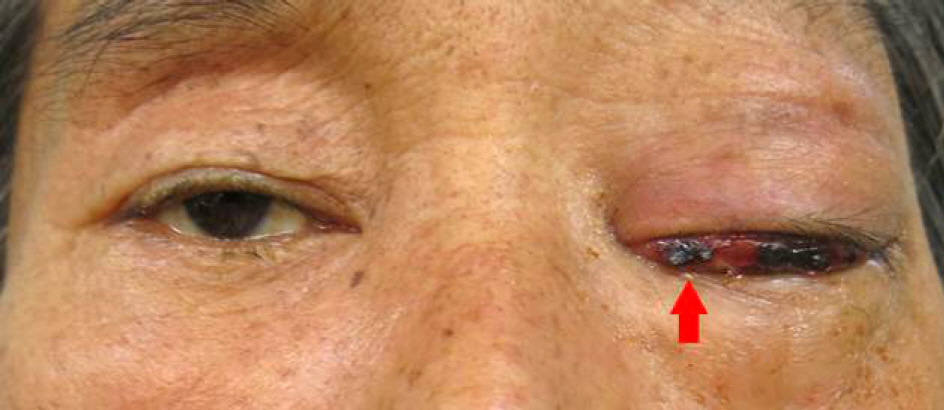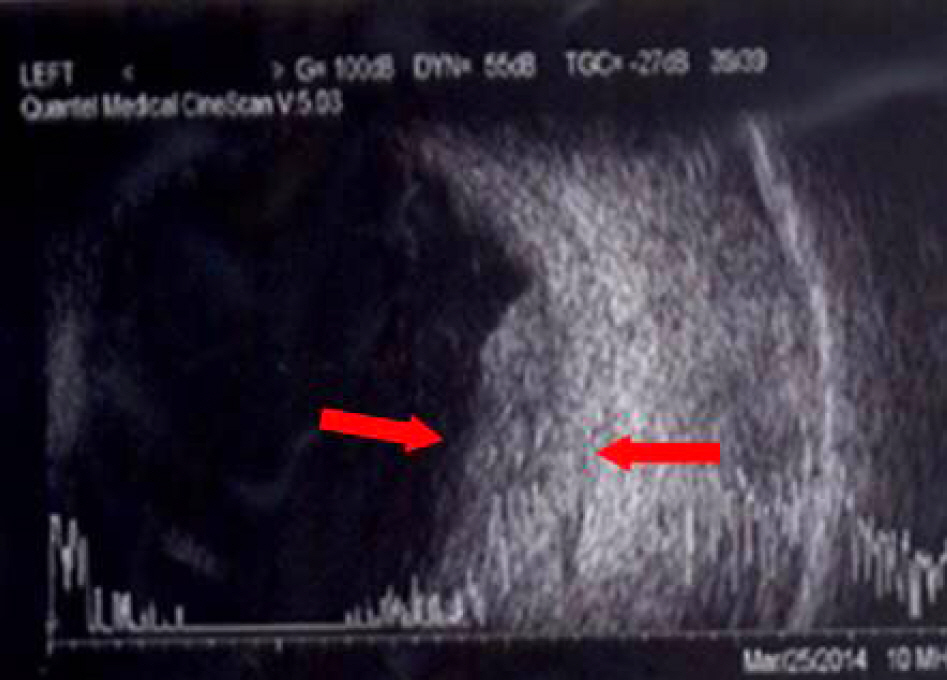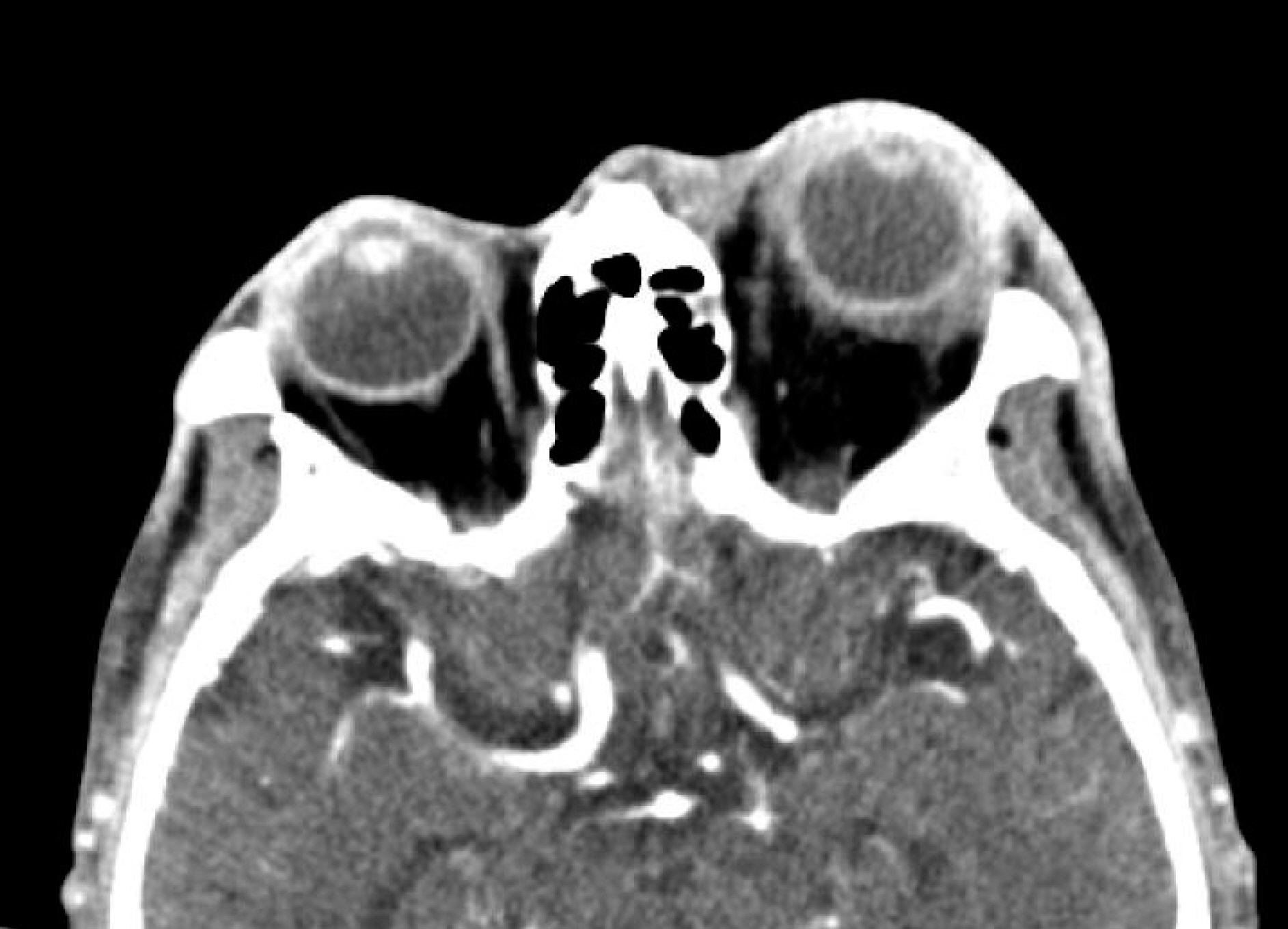J Korean Ophthalmol Soc.
2016 Jul;57(7):1139-1143. 10.3341/jkos.2016.57.7.1139.
Endogenous Endophthalmitis Due to Klebsiella ozaenae
- Affiliations
-
- 1Department of Ophthalmology, Gachon University Gil Medical Center, Incheon, Korea. cmj@gilhospital.com
- 2Department of Internal Medicine, Gachon University Gil Medical Center, Incheon, Korea.
- KMID: 2317576
- DOI: http://doi.org/10.3341/jkos.2016.57.7.1139
Abstract
- PURPOSE
To report a case of endogenous endophthalmitis due to Klebsiella ozaenae, which is a rare causative organism of endophthalmitis.
CASE SUMMARY
A 61-year-old male who was undergoing chemotherapy for hepatocellular carcinoma complained of sudden visual loss and ocular pain in his left eye for 2 days. On the first examination, the patient's visual acuity was counting fingers at 10 cm and the intraocular pressure was elevated to 29 mm Hg. Partial scleral rupture and choroidal prolapse were observed. Subretinal abscess was detected with increased echogenicity using ultrasonography. The patient complained of burning sensation on voiding and urinary frequency; subsequent urinalysis showed pyuria and bacteriuria. Intravitreal and systemic antibiotics were administered under the impression of endogenous endophthalmitis caused by urinary tract infection. Despite treatment, visual acuity decreased to no light perception in 4 days and intraocular pressure and pain was uncontrollable. Enucleation was performed and pus culture from the eye during surgery revealed Klebsiella ozaenae.
CONCLUSIONS
Klebsiella ozaenae is a rare causative organism of endophthalmitis and shows a rapid progress and poor prognosis. Endogenous endophthalmitis must be highly suspected in patients with urinary tract infection as well as pyogenic liver abscess.
MeSH Terms
-
Abscess
Anti-Bacterial Agents
Bacteriuria
Burns
Carcinoma, Hepatocellular
Choroid
Drug Therapy
Endophthalmitis*
Fingers
Humans
Intraocular Pressure
Klebsiella*
Liver Abscess, Pyogenic
Male
Middle Aged
Prognosis
Prolapse
Pyuria
Rupture
Sensation
Suppuration
Ultrasonography
Urinalysis
Urinary Tract Infections
Visual Acuity
Anti-Bacterial Agents
Figure
Reference
-
References
1. Jackson TL, Eykyn SJ, Graham EM, Stanford MR. Endogenous bacterial endophthalmitis: a 17-year prospective series and review of 267 reported cases. Surv Ophthalmol. 2003; 48:403–23.
Article2. Irvine WD, Flynn HW Jr, Miller D, Pflugfelder SC. abdominal caused by gram-negative organisms. Arch Ophthalmol. 1992; 110:1450–4.3. Yoon YH, Lee SU, Sohn JH, Lee SE. Result of early vitrectomy for abdominal Klebsiella pneumoniae endophthalmitis. Retina. 2003; 23:366–70.4. Yang CS, Tsai HY, Sung CS, et al. Endogenous Klebsiella endophthalmitis associated with pyogenic liver abscess. Ophthalmology. 2007; 114:876–80.
Article5. Goldstein EJ, Lewis RP, Martin WJ, Edelstein PH. Infections caused by Klebsiella ozaenae: a changing disease spectrum. J Clin Microbiol. 1978; 8:413–8.
Article6. Lewis JF, Alexander JJ. Meningitis and septicemia due to abdominal ozaenae. Am J Clin Pathol. 1979; 72:1033–4.7. Strampfer MJ, Schoch PE, Cunha BA. Cerebral abscess caused by Klebsiella ozaenae. J Clin Microbiol. 1987; 25:1553–4.
Article8. Janda WM, Hellerman DV, Zeiger B, Brody BB. Isolation of Klebsiella ozaenae from a corneal abscess. Am J Clin Pathol. 1985; 83:655–7.
Article9. Murray KA, Clements BH, Keas SE. Klebsiella ozaenae septicemia associated with Hansen's disease. J Clin Microbiol. 1981; 14:703–5.10. Botelho-Nevers E, Gouriet F, Lepidi H, et al. Chronic nasal abdominal caused by Klebsiella rhinoscleromatis or Klebsiella abdominal: two forgotten infectious diseases. Int J Infect Dis. 2007; 11:423–9.11. Danilowicz K, Sanz CF, Manavela M, et al. Pituitary abscess: a abdominal of two cases. Pituitary. 2008; 11:89–92.12. Ng TH, How SH, Kuan YC, et al. A mimicry of melioidosis by Klebsiella ozaenae infection. Malays J Pathol. 2009; 31:147–50.13. Lee YH, Choi SJ, Kim IC, Chung YT. A case of the bilateral abdominal endophthalmitis. J Korean Ophthalmol Soc. 1995; 36:2048–53.14. Shim HS, Lee SS, Park JM, Song JK. Three cases of the metastatic endophthalmitis. J Korean Ophthalmol Soc. 1994; 35:349–55.15. La TY, Kim CW, Lee JS. A case of endogenous endophthalmitis accompanying orbital cellulitis caused by Klebsiella pneumoniae from liver abscess. J Korean Ophthalmol Soc. 2000; 41:1000–5.16. Lee SM, Lee SH, Choi YJ, Kim IT. Two cases of endogenous endophthalmitis. J Korean Ophthalmol Soc. 1997; 38:2064–70.17. Sung KR, Lee YB, Kim CH, et al. Clinical aspects of infectious abdominal endophthalmitis. J Korean Ophthalmol Soc. 1999; 40:176–81.18. Lee SJ, Lee M, Kwak HW. Clinical aspect of bacterial endogenous endophthalmitis. J Korean Ophthalmol Soc. 2000; 41:112–8.19. Oh TS, Ahn Y, Chang SD, Lee YK. A Case of endogenous endophthalmitis caused by Klebsiella pneumoniae from emphysematous pyelonephritis. J Korean Ophthalmol Soc. 2002; 43:1330–4.20. Liao HR, Lee HW, Leu HS, et al. Endogenous Klebsiella pneumoniae endophthalmitis in diabetic patients. Can J Ophthalmol. 1992; 27:143–7.21. Wong JS, Chan TK, Lee HM, Chee SP. Endogenous bacterial abdominal: an east Asian experience and a reappraisal of a abdominal ocular affliction. Ophthalmology. 2000; 107:1483–91.22. Podschun R, Ullmann U. Klebsiella spp. as nosocomial pathogens: epidemiology, taxonomy, typing methods, and pathogenicity abdominals. Clin Microbiol Rev. 1998; 11:589–603.23. Uh Y, Park SD, Son JS, et al. Identification, antimicrobial abdominal and epidemiology of Klebsiella species isolated from clinical specimen. Korean J Clin Microbiol. 2000; 3:99–110.24. Okada AA, Johnson RP, Liles WC, et al. Endogenous bacterial abdominal. Report of a ten-year retrospective study. Ophthalmology. 1994; 101:832–8.25. Results of the Endophthalmitis Vitrectomy Study. A randomized trial of immediate vitrectomy and of intravenous antibiotics for the treatment of postoperative bacterial endophthalmitis. abdominal Vitrectomy Study Group. Arch Ophthalmol. 1995; 113:1479–96.26. Hwang JH, Cho NC. Prognostic factors in patients with abdominal endophthalmitis. J Korean Ophthalmol Soc. 2009; 50:858–63.27. Byun YC, Lee H, Lee EK, Lee KW. A case of metastatic enoph-thalmitis originated from bacterial endocarditis. J Korean abdominal Soc. 1994; 35:122–7.28. Ang M, Jap A, Chee SP. Prognostic Factors and Outcomes in Endogenous Klebsiella pneumoniae endophthalmitis. Am J abdominal. 2011; 151:338–44.e2.
Article29. Sipperley JO, Shore JW. Septic retinal cyst in endogenous Klebsiella endophthalmitis. Am J Ophthalmol. 1982; 94:124–5.
Article30. Wang FD, Wang LS, Liu YC, et al. Successful treatment of metastatic endophthalmitis. Case reports. Ophthalmologica. 1989; 198:124–8.31. Chee SP, Ang CL. Endogenous Klebsiella endophthalmitis-a case series. Ann Acad Med Singapore. 1995; 24:473–8.32. Sridhar J, Flynn HW Jr, Kuriyan AE, et al. Endophthalmitis caused by Klebsiella species. Retina. 2014; 34:1875–81.
Article33. Greenwald MJ, Wohl LG, Sell CH. Metastatic bacterial endophthalmitis: a contemporary reappraisal. Surv Ophthalmol. 1986; 31:81–101.
Article
- Full Text Links
- Actions
-
Cited
- CITED
-
- Close
- Share
- Similar articles
-
- Klebsiella pneumoniae Brain Abscess and Endophthalmitis after Acute Epiglottitis
- Two Cases of Klebsiella Pneumoniae Endogenous Endophthalmitis Treated with Sulperazone
- A Case of Endogenous endophthalmitis Caused by Klebsiella Pneumoniae from Emphysematous Pyelonephritis
- Two Cases of Bilateral Endogenous Klebsiella pneumoniae Endophthalmitis in Primary Klebsiella pneumoniae Liver Abscess Patients
- Endogenous Klebsiella Endophthalmitis Concurrent with Prostate and Perianal Abscesses




